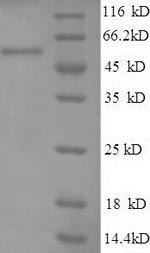Amino acids 60-308 form the expressed segment for recombinant Human TRAP1. The theoretical molecular weight of the TRAP1 protein is 54.5 kDa. This TRAP1 recombinant protein is manufactured in e.coli. The N-terminal GST tag was fused into the coding gene segment of TRAP1, making it easier to detect and purify the TRAP1 recombinant protein in the later stages of expression and purification.
The human heat shock protein 75 kDa, mitochondrial (TRAP1) is a molecular chaperone located in the mitochondria. TRAP1 belongs to the HSP90 family and plays a critical role in mitochondrial protein folding, stability, and cellular stress response. TRAP1 is involved in the regulation of mitochondrial functions, including energy production and apoptosis. As a chaperone, TRAP1 assists in the proper folding of mitochondrial proteins, maintaining mitochondrial homeostasis. Its role in cellular stress response makes TRAP1 a key player in protecting cells from various stressors, including oxidative stress. Research on TRAP1 explores its functions in mitochondrial biology, cellular stress adaptation, and its potential implications in diseases such as cancer, where mitochondrial dysfunction is often observed.






